MARIANI’S
Virtual
Gourmet
November
8, 2015
NEWSLETTER
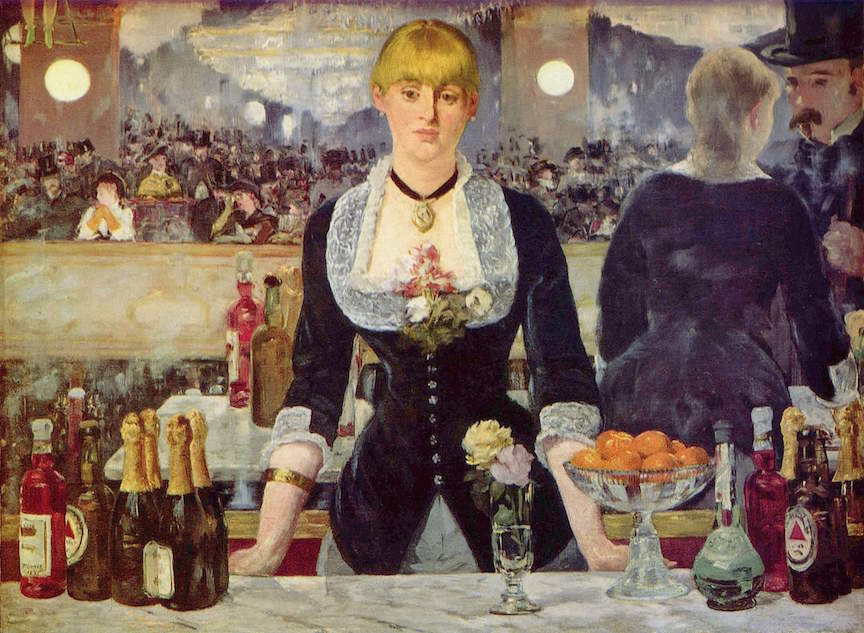
"Bar at the Folies Bergère" (1882) By Édouard Manet
❖❖❖
IN THIS ISSUE
WHITE HART INN
By John Mariani
NEW YORK CORNER
BYBLOS
By John Mariani
NOTES FROM THE WINE CELLAR
AIA VECCHIA
By John Mariani
❖❖❖
WHITE HART INN
Salisbury, Connecticut
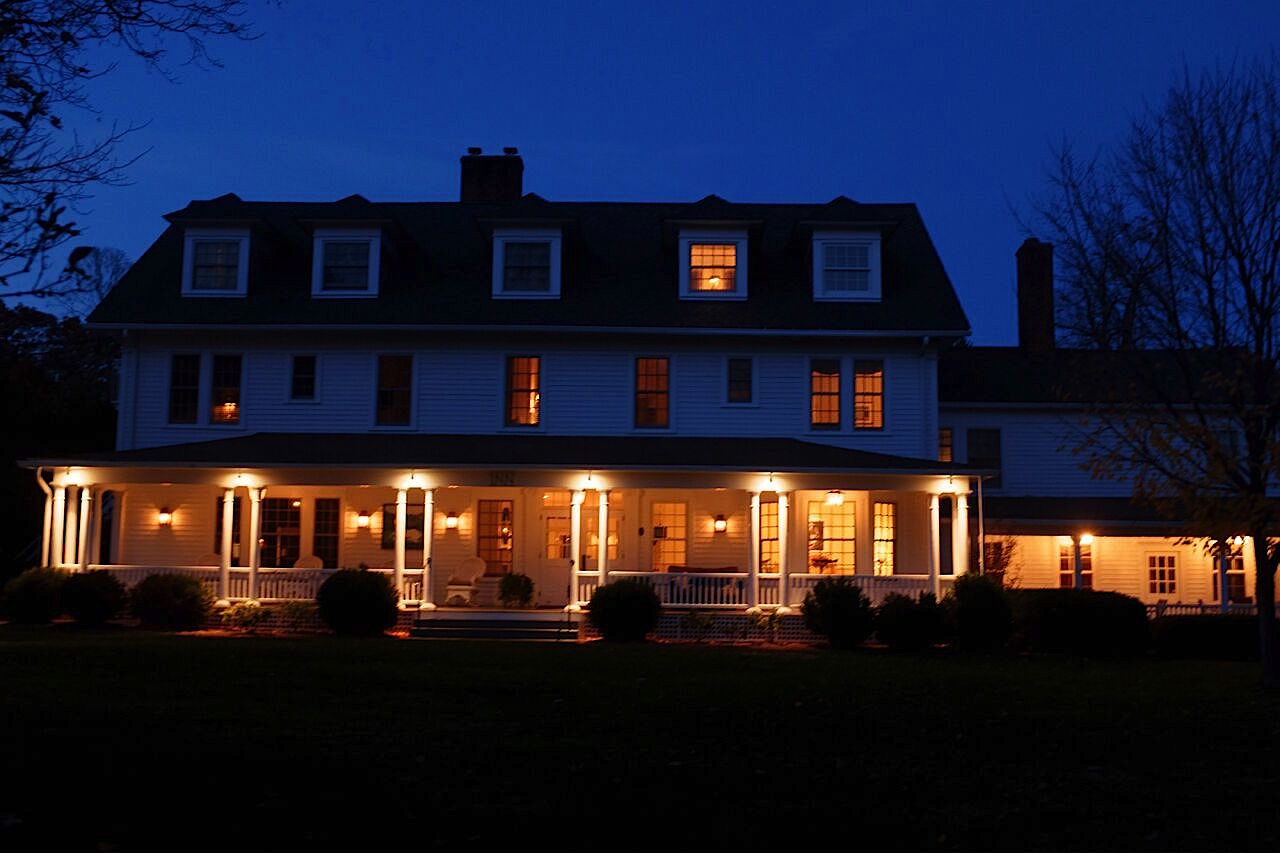
By John Mariani
There
seems
little reason to encourage readers to visit
well-known, upscale New England inns in early
autumn because the leaf-peepers have already
booked all the rooms. But right about now,
with the foliage falling, the idea of a trip to a
cozy Connecticut inn with excellent food seems a
capital idea, with an eye towards the December
holidays.
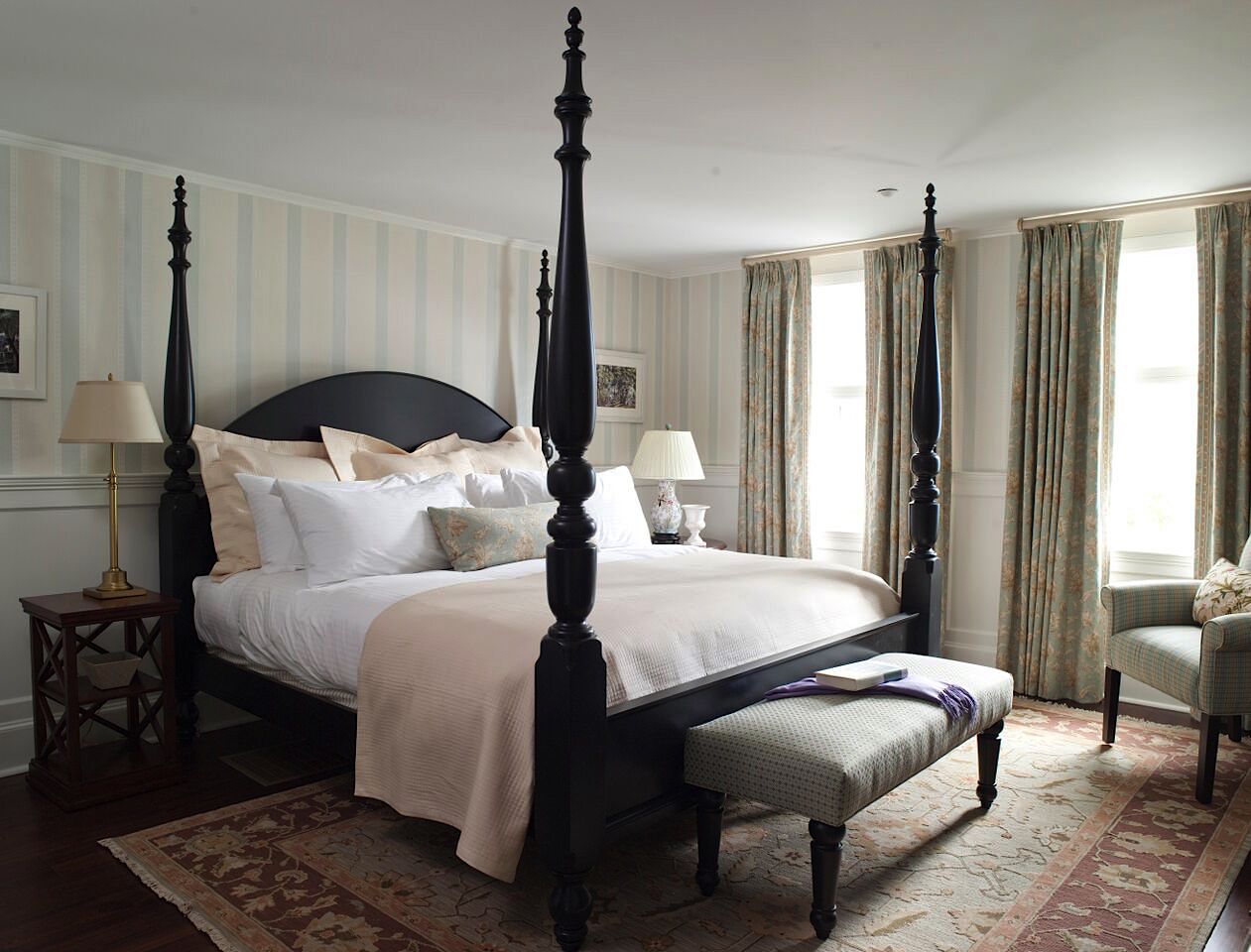 The White
Hart Inn in Salisbury, CT, is open year-round, just
two hours from New York and about three from Boston
and two from Providence. The structure dates back to
the mid-19th century and was recently restored to a
facsimile of its original décor, but with all modern
amenities and a very fine restaurant. Its location
allows guests to visit antiques shops and
bookstores, ski at Mohawk Mountain, less than 30
minutes away, go ice and fly fishing, or hiking and
biking the Appalachian Trail. There is
also race car driving at
nearby Lime Rock Park. And this fall the Inn itself
is holding a series of talks by well known
authors.
The White
Hart Inn in Salisbury, CT, is open year-round, just
two hours from New York and about three from Boston
and two from Providence. The structure dates back to
the mid-19th century and was recently restored to a
facsimile of its original décor, but with all modern
amenities and a very fine restaurant. Its location
allows guests to visit antiques shops and
bookstores, ski at Mohawk Mountain, less than 30
minutes away, go ice and fly fishing, or hiking and
biking the Appalachian Trail. There is
also race car driving at
nearby Lime Rock Park. And this fall the Inn itself
is holding a series of talks by well known
authors.
The small town of
Salisbury, population 3,700, grew around the Inn
with little to suggest its colonial character, but
the White Hart endured as a weekend getaway until a
sudden closure in 2010, even as it was undergoing a
renovation. Fortunately, the new owners,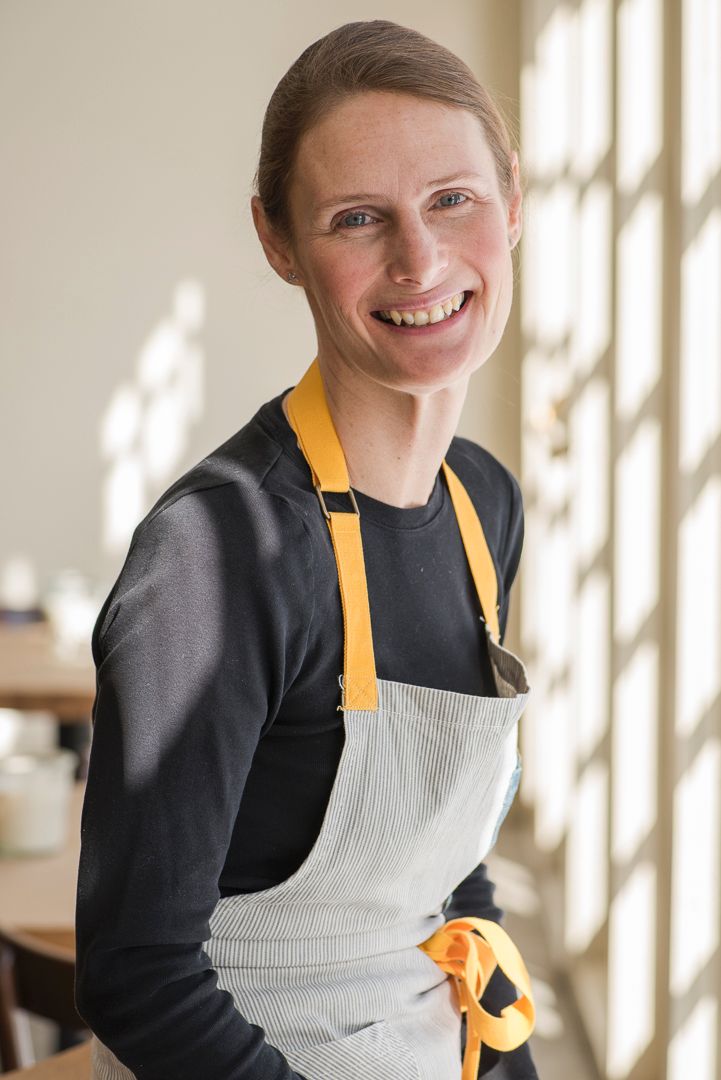 Conley and
Meredith Rollins, Malcolm Gladwell, and British chef
Annie Wayte (right),
have joined a line of caretakers that have included
Edsel Ford and tea
producer John Harney, and the renovations allowed
the Inn to open just about a year ago.
Conley and
Meredith Rollins, Malcolm Gladwell, and British chef
Annie Wayte (right),
have joined a line of caretakers that have included
Edsel Ford and tea
producer John Harney, and the renovations allowed
the Inn to open just about a year ago.
Photo by John Gruen
So the White Hart now has 16 beautifully
furnished rooms, some adjacent to the main
three-story building, whose porch overlooks the
village green. Inside, amidst polished wood and
painted wainscoting, an array of unexpected modern
art by artists Jasper Johns, Frank Stella, Terry
Winters and Tom Levine on the walls.
The casual dining option here is
the Tap Room, a pub serving “British comfort fare”
(daily for lunch and dinner) that includes duck
shepherd's pie, Scotch egg, tuna burger, and chili. There is
also a breakfast room that, while sunny, could
certainly use some color and décor, for it now has
none at all.
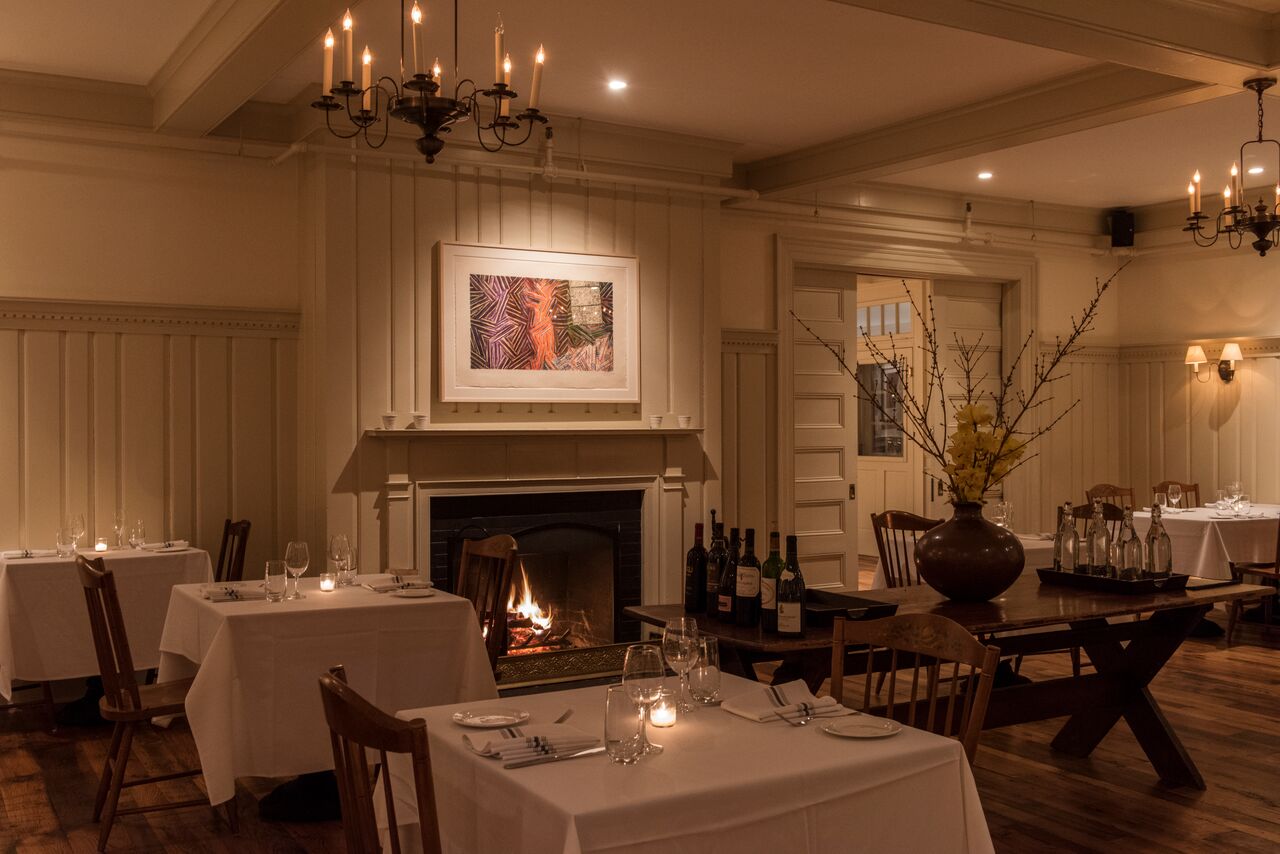 On
the other side of the building is the restaurant,
itself quite casual but with a more serious menu
that shows off Annie Wayte’s considerable finesse
with both traditional and modern cookery. Paul
Pearson is Executive Chef.
On
the other side of the building is the restaurant,
itself quite casual but with a more serious menu
that shows off Annie Wayte’s considerable finesse
with both traditional and modern cookery. Paul
Pearson is Executive Chef.
The 20-seat dining room mimics
the colonial décor elsewhere, with a roaring
fireplace and a long, centrally situated wooden
table topped with seasonal bounty. They have sadly
ditched the white tablecloths in the photo for
wrinkled, abbreviated gingham.
Right off the mark, Wayte’s leek
and goat’s cheese raviolo with corn, chanterelles
and brown butter ($14) seemed the epitome of autumn,
well textured and luxuriant in its simple saucing. I hardly
expected pastrami to be on the menu here, but it was
really very good, served with beets,
cucumber-mustard crème fraîche and slices of
pumpernickel ($14).
One of our
main courses was a perfectly rosy breast of duck
with a nice layer of fat and crisp skin enhanced
with a rich foie gras custard, kale, and piquant
raspberries ($34).
The big option here is the hearty confit of
pork belly with cured cabbage, mustard-glaze
kohlrabi and sweet blueberries ($29)—a really
masterful marriage of disparate flavors, accents,
textures, and heat.
My wife and I could not refuse a
cheese course ($16) from New England artisans, then
ended our splendid meal with a warm plum clafoutis
and hazelnut ice cream, served for two ($12), and an
old favorite rarely seen much anymore, peach ice
cream with a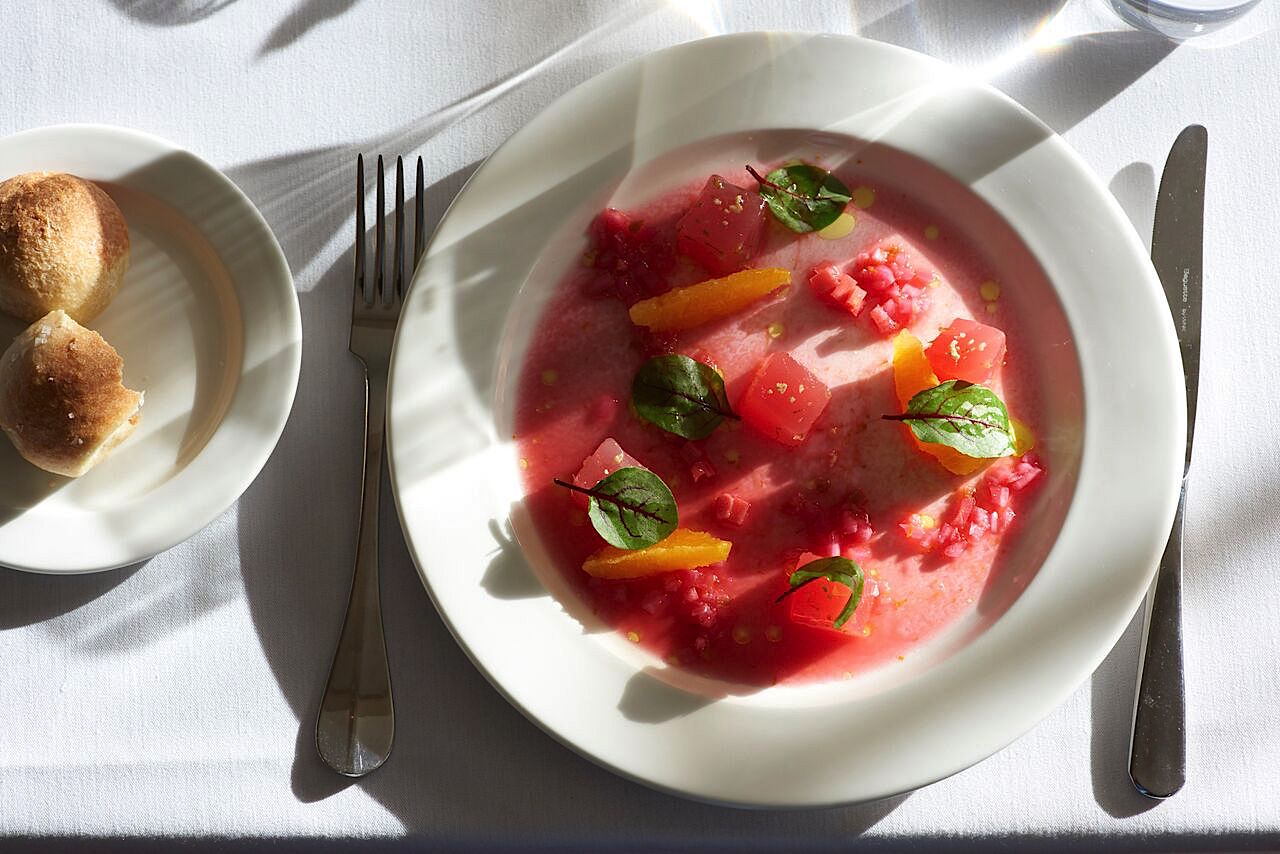 raspberry compote and
Graham cracker ($8)—all by pastry chef Gaby Rios,
whose puffy Parker House rolls have been a big hit
at the
Inn.
raspberry compote and
Graham cracker ($8)—all by pastry chef Gaby Rios,
whose puffy Parker House rolls have been a big hit
at the
Inn.
It
would be hard to come by a better meal on a cool
November evening, each element based on what is
seasonably and locally available. You go off to bed,
perhaps after a glass of Port or Cognac, with a sure
feeling of well-being. At the moment, however, you
may dine at the restaurant only on Fridays and
Saturdays.
The guest rooms (starting at
$225) are all lovely and all different, done by NYC
designer Matthew Patrick Smyth, known largely
for his residential work. The number of rooms has been
reduced to provide far more space, ranging from
standard rooms to suites with two and a half baths
and a small living room area; the
largest “John Harney” suite is composed of two king
bedrooms, a kitchenette and a living room area with
a pull-out couch. All the linens are by Frette,
which gives the White Hart a luxury few New England
inns even attempt to match.
Cozy hardly does justice
to the White Hart Inn. It is that, albeit in a very
elegant way, but it’s also representative of how
likeminded people of finely tuned taste and respect
for history can turn something quaint into something
truly remarkable.
WHITE HART INN
15 Undermountain Rd.
Salisbury
860-435-0300
www.whitehartinn.com
❖❖❖
By John Mariani
Byblos
80 Madison Avenue (near 27th Street)
212-607-0808
byblosny.com
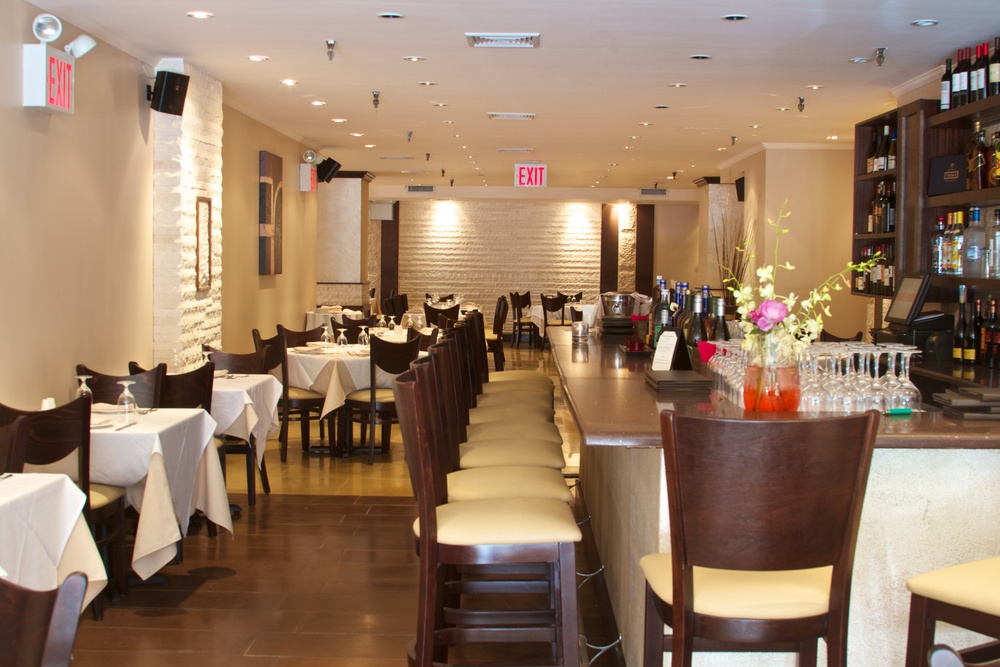 The
cuisine of the Levant is certainly well
represented in NYC, though rarely does it
receive the panting praise lavished on those
fleeting darlings that the food media is
infatuated with at any given moment, which right
now seems to be Southeast Asian and Mexican. Yet,
the food of the Middle East, especially Lebanon,
sails on, oblivious to trends and consistent
year after year.
The
cuisine of the Levant is certainly well
represented in NYC, though rarely does it
receive the panting praise lavished on those
fleeting darlings that the food media is
infatuated with at any given moment, which right
now seems to be Southeast Asian and Mexican. Yet,
the food of the Middle East, especially Lebanon,
sails on, oblivious to trends and consistent
year after year.
Among the
most practiced is Byblos, whose longtime restaurateur/chef
Sabeh Kachouh, with his charming wife Sonia, has
never wavered in his dedication to providing an
exceptionally wide variety of delicacies, not
least a table groaning with color-bright mézès. He is
an educator, intent on teaching guests just how
deep and broad the cuisine of his native country
really is.
The 90-seat
restaurant has its own brightness, fronted by a
12-foot long, L-shaped marble and cherry wood bar,
which has a very good selection of Lebanese wines
(many by the glass). The restaurant is an
incarnation of the original premises in Murray
Hill, where Byblos 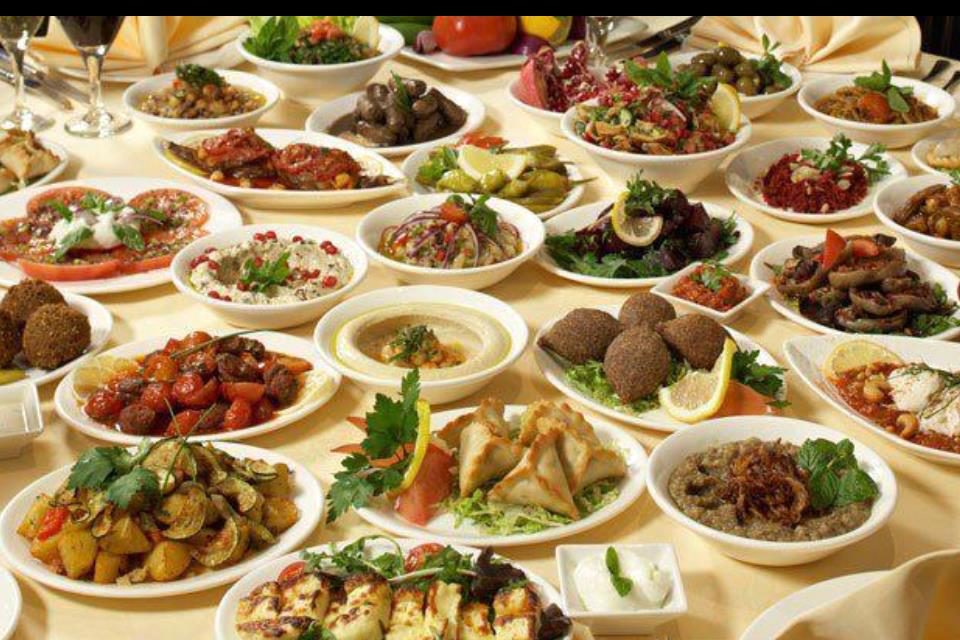 (named
after one of the oldest cities in the world)
opened in 1990.
A fire destroyed that building so the
Kachouhs shifted west to the Flatiron District
three years ago.
The new, long, wide and airy room is done
in creamy colors, rough stone walls, dark accents,
and fine lighting over generous tables with white
linens.
(named
after one of the oldest cities in the world)
opened in 1990.
A fire destroyed that building so the
Kachouhs shifted west to the Flatiron District
three years ago.
The new, long, wide and airy room is done
in creamy colors, rough stone walls, dark accents,
and fine lighting over generous tables with white
linens.
You need that generosity once the mezzes
start coming out. We asked Kachouh
to bring out whatever and as many dishes as he
liked from a menu of fifty options, and I think we
were served every one, from delectably creamy
varieties of hummus to the lovely baba ghannouj
of charcoal grilled eggplant, tahini,
olive oil, lemon juice, and garlic. Then came labaneh,
a thick cheese dressed with olive oil and dried
mint, and there were the inevitable grape leaves,
here stuffed with rice and chickpeas. Muhammara
was a spicy red pepper dip mixed with walnuts, and
balila
were fat chickpeas dressed with garlic, lemon,
olive oil and Lebanese seasonings. The
Lebanese names for their dishes are as euphonious
as they are enticing.
We’d
only just begun. Out came kibbee naye
tartare mixed lightly with wheat and spices,
as well as a simmered chicory called hindby. Our
appetites were roaring now, delighted with the
arrival of falafel
fragrant with coriander served with tahini sauce,
and one of Byblos’ specialties: marinated, grilled
quail and makanik
lamb sausages. Batata harra
were cubed  potatoes
with chopped cilantro, garlic, and pepper, while jawaneh were
plump chicken wings sautéed with the same
seasonings and herbs.
potatoes
with chopped cilantro, garlic, and pepper, while jawaneh were
plump chicken wings sautéed with the same
seasonings and herbs.
Somehow we were not yet on the wane, so we gobbled
up arayess,
a dish of toasted pita filled with minced meat,
and deep-fried
rikakat
with halloumi
cheese. Then there was a variety of flaky zaatar
pies, scented with thyme, sesame, olive oil and
sumac.
Oh, and there were charcoal grilled kebabs and
succulent stuffed lamb breast entrees, five
seafood dishes, including the fried Sultan Ibraham
fish, and much more, including delicious Lebanese
desserts—flaky, honey-drenched pastries.
Whatever the Lebanese word for “uncle” is, we
cried out that we were full, washing it all down
with well-rendered Lebanese coffee.
That
Byblos can turn out so many dishes—albeit with
many repeated ingredients—of such obvious
freshness, tenderness, juiciness, and color is
testament to decades of perfecting everything
while pleasing guests who may come for a few
favorite dishes, then go on to find there are so
many more at this ebullient and highly familial
venture where too much seems just about
right.
Byblos is open for lunch and dinner daily;
3-Course Prix Fixe Dinner $48, Mezzes
$6-$18, main courses $22-$32. Saturday,
Lebanese music and belly dancing.
❖❖❖
NEW TUSCAN WINES FROM AN OLD TUSCAN FAMILY
By John Mariani
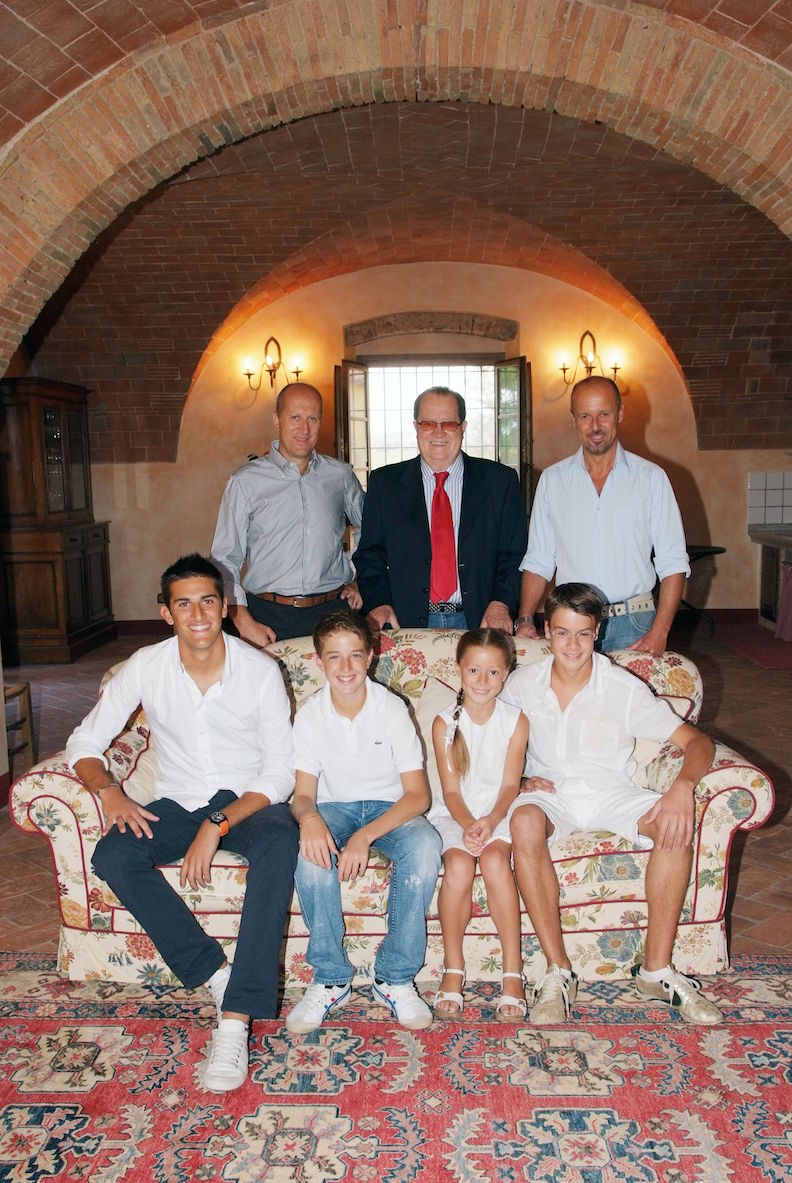 You
can
tell from his enthusiasm and energy that
26-year-old Elia Pellegrini (far left)
must have made a great pro soccer player in the
Italian Leagues before joining the
family
business in Bolgheri, a region famous in the
past for cheap Chianti and, more recently, for
extravagantly priced “Super Tuscan wines,” a
hyped name that the better wine producers of
the region now disdain.
You
can
tell from his enthusiasm and energy that
26-year-old Elia Pellegrini (far left)
must have made a great pro soccer player in the
Italian Leagues before joining the
family
business in Bolgheri, a region famous in the
past for cheap Chianti and, more recently, for
extravagantly priced “Super Tuscan wines,” a
hyped name that the better wine producers of
the region now disdain.
Over dinner at NYC's Lincoln
Ristorante, Elia said, "Our family is
fourth generation here and we are the only ones
left who are from
Bolgheri," despite there now being nearly forty
members of the Bolgheri Consortium, spread over
2,650 acres. “The
Consorzio Bolgheri is mainly for the
protection and the promotion of the Bolgheri DOC.”
Indeed, so many outsiders—even from outside
Tuscany—bought up land in order to capitalize on
the Super Tuscan surge of the 1990s that today,
according to Pellegrini, “There’s no longer any
profit in building a new winery in Bolgheri. It’s
become far too expensive. Only
because we have been here a long time can we
afford to buy two hectares recently in which to
plant cabernet franc and petit verdot. We will
also have a new agrotourism villa in 2018—six
rooms where people may stay and eat and
drink—along with an aging cellar and vineyards.”
Under
their Aia Vecchia (“Old Barn”) label, the
Pellegrinis produce four wines, three reds and one
white, made from two estates comprising 118 acres,
with 74 acres under the Bolgheri DOC by winemaker
Nicolo Scottini.
Tuscany is not known for its
white wines, but I find Aia Vecchia’s Vermentino
2014 ($12), made from 95% vermentino  and 5% viognier for
its aromatic effect, is one of the most delicious
made in the region.
It’s fruitedness and good acid make it fine
for an aperitif, for it is very fresh, spending
four months in stainless steel, none in oak
barrels, and two in bottle. It is
made to be enjoyed right away, especially with a
platter of Italian salumi and Prosciutto, or scampi
cooked in the wine itself.
and 5% viognier for
its aromatic effect, is one of the most delicious
made in the region.
It’s fruitedness and good acid make it fine
for an aperitif, for it is very fresh, spending
four months in stainless steel, none in oak
barrels, and two in bottle. It is
made to be enjoyed right away, especially with a
platter of Italian salumi and Prosciutto, or scampi
cooked in the wine itself.
 Lagone
2013 shows far more character and depth that
its modest $15 price indicates. The
blend of 60% merlot, 30% cabernet sauvignon and
10% cabernet franc ages for 12 months in oak barriques,
developing wood and tannin but, because it is
mostly merlot, it has a soft ripeness that makes
it perfect for autumn dishes and most robust
pastas like lasagne
alla bolognese as well as a grilled veal
chop. Its
components will remind you of a very fine wine
from France’s Saint-Émilion region.
Lagone
2013 shows far more character and depth that
its modest $15 price indicates. The
blend of 60% merlot, 30% cabernet sauvignon and
10% cabernet franc ages for 12 months in oak barriques,
developing wood and tannin but, because it is
mostly merlot, it has a soft ripeness that makes
it perfect for autumn dishes and most robust
pastas like lasagne
alla bolognese as well as a grilled veal
chop. Its
components will remind you of a very fine wine
from France’s Saint-Émilion region.
Aia Vecchia’s top-of-the-line red, Sorugo 2010
($35), made from 50% cabernet sauvignon, 30%
merlot, 15% cabernet franc, and 5% petit verdot is
labeled merely as “Bolgheri Rosso Superiore,”
which barely hints at its complexity and elegance. Aged in
new French oak for 18 months, then in bottle for
another year, the wine’s body comes from the
cabernet sauvignon, the merlot mellows the wine,
the cabernet franc gives it further depth, and the
petit verdot provides aroma and a nice cut of acid
that knits it all together. It is as a red wine
highly suited to
dishes like rack of lamb, Prime rib of
beef, and winter’s game dishes. Decant
this wine in the vicinity of sliced white
truffles, and you may faint from the perfume of
the marriage.
❖❖❖
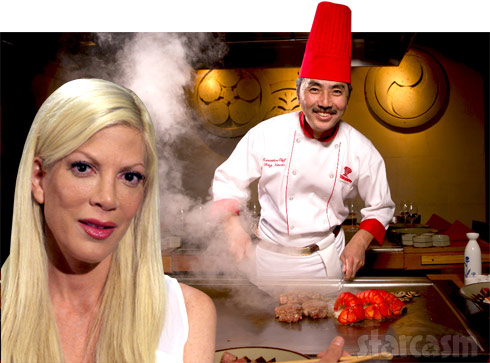 HOT PANTS
HOT PANTS
Actress Tori Spelling sued
Benihana
Japanese steakhouse after she tripped and fell
backwards onto a hot grill at one of the locations
in Los Angeles, saying she was badly burned and is
seeking more than $25,000 in compensatory damages
for lost earnings.
BLOCK THAT METAPHOR!!!

The Beautiful Dark One: A Super Tuscan
Retrospective
By John Fodera, Tuscan Vines
 About 15
minutes south from the center of Montalcino, in the
bucolic Tuscan countryside, sits Castello
Banfi gracefully perched on a hillside surrounded
by sloping vineyards. Home to the leading Brunello
producer in Montalcino, Castello Banfi crafts an array
of estate-grown wines. One of those wines is
BelnerO, a project personally spearheaded by co-CEO
and family proprietor Cristina Mariani-May. According
to her, BelnerO is special because:
About 15
minutes south from the center of Montalcino, in the
bucolic Tuscan countryside, sits Castello
Banfi gracefully perched on a hillside surrounded
by sloping vineyards. Home to the leading Brunello
producer in Montalcino, Castello Banfi crafts an array
of estate-grown wines. One of those wines is
BelnerO, a project personally spearheaded by co-CEO
and family proprietor Cristina Mariani-May. According
to her, BelnerO is special because:
“The years of pioneering research that
Castello Banfi has undergone has helped create a
Sangiovese that is so unique and specialized to our
terroir and a counter statement to our
Brunellos. The expressions of Sangiovese are very
diverse and we are proud that we are able to
experiment on our estate with various clones of
Sangiovese, terroirs, and winemaking techniques. I
love BelnerO because it represents all that Castello
Banfi is: innovative, based on years of dedicated
research, pioneering, an outstanding value and
bearing a taste profile that many consumers love.”
Loosely translated as
"Beautiful Dark One," BelnerO is predominantly
Sangiovese produced from vines specifically identified
in Castello Banfi's clonal research project as being
optimally suited for the microclimate. BelnerO is
almost entirely Sangiovese, but typically has a small
percentage (less than 10%) of Merlot or Cabernet
blended into the wine. Fermentation takes place
in Castello Banfi's patented hybrid fermenters and the
wine is then aged in French barrique, only 30%
of which are new, for 14 months. At least 6
months bottle aging is employed prior to release.First
produced in 2005, it is easy for me to see the
development in this wine since that time. As the
vines mature, the wine has grown to show more
complexity, more finesse and more
elegance. Recently, I tasted the three most
recent vintages of BelnerO; following are my tasting
notes.
2009 Castello Banfi
BelnerO:
In the glass, the wine is a dark crimson
red with violet overtones. At once the nose is
redolent with crushed berries, flowers, and a lovely
dusty "Tuscan road character". It evokes an
image. On the palate, the wine carries itself broadly,
with long lasting waves of crushed black cherry fruit
that are spicy, juicy and well delineated. It has a
tinge of black olive and a tobacco-like
sweetness. Shows lots of freshness in this
hotter than optimal vintage. 90 points.
2010 Castello Banfi
Belnero:
From what is fast becoming a legendary
vintage in Montalcino, the 2010 is deep purple in the
glass trending toward a saturated garnet ruby
color. The aromas are gorgeous with ample
crushed plum, warm road dust, cured olive, and fresh
tobacco. Really interesting to smell and it kept
me going back to the glass. On the palate, the
wine is much more primary. There's a solid core
of elegant black plum and berry wrapped in spices and
a pleasing black olive notes. Hint of rosemary
on the finish. The balance is wonderful and the
ripe tannins assert themselves on the finish.
This is delicious but needs cellaring to round out the
tannins and develop more complexity. An
interesting comparison side by side against the more
advanced 2009. Give it 3-5 years in the
cellar. 92 points.
2011 Castello Banfi
BelnerO:
On the heels of 2010 comes 2011, a
vintage that not many are paying attention to at the
moment. However, in Chianti Classico and
Maremma the weather was wonderful and many have rated
the vintage on par or ahead of 2010. Time will
tell how it bears out for Montalcino but if this wine
is any indication, things look promising. The 2011
BelnerO is a gorgeous deep ruby color with violet
highlights. It seems "brighter" than the
previous two examples. In the glass, the aromas
are penetrating. Crushed red fruits, fresh
flowers, exotic baking spices, and sweet tobacco are
perfumed and persistent. On the palate, the wine
is elegant, fresh and vibrant. Juicy red fruit
flavors are accented with dusty cinnamon, pipe tobacco
and a slight touch of mocha. Balanced well, this
is approachable right now but will easily cellar for
5-7 years. 91 points.
In wrapping this up, I
think an important take away from these tastings is
the absence of a notable flavor profile from the
international varietals in the blend. These
wines behaved like classy Sangiovese and represent a
singular expression of the Montalcino microclimate
that is notably different from Brunello. The
vagaries of each vintage were easily discernible in
the three wines and in better years like 2010, BelnerO
achieves a level of complexity and power that
approaches Brunello. That brings us to the value
aspect. For a multitude of reasons pertaining to the
oddities of the wine market, pricing fluctuates widely
on this wine, so shop around. While it's a relative
bargain compared to Brunello at $30, it's an absolute
steal compared to similar Sangiovese wines under that
price.
Salute!
Any of John Mariani's books below may be ordered from amazon.com.
 I'm proud and happy to announce that my
new book, The Hound
in Heaven (21st Century Lion Books), has just
been published through Amazon and Kindle.
I'm proud and happy to announce that my
new book, The Hound
in Heaven (21st Century Lion Books), has just
been published through Amazon and Kindle. It is a novella, and for anyone who loves dogs, Christmas, romance, inspiration, even the supernatural, I hope you'll find this to be a treasured favorite. The story concerns how, after a New England teacher, his wife and their two daughters adopt a stray puppy found in their barn in northern Maine, their lives seem full of promise. But when tragedy strikes, their wonderful dog Lazarus and the spirit of Christmas are the only things that may bring back his master back from the edge of despair.
WATCH THE VIDEO!
“What a huge surprise turn this story took! I was completely stunned! I truly enjoyed this book and its message.” – Actress Ali MacGraw
“He had me at Page One. The amount of heart, human insight, soul searching, and deft literary strength that John Mariani pours into this airtight novella is vertigo-inducing. Perhaps ‘wow’ would be the best comment.” – James Dalessandro, author of Bohemian Heart and 1906.
“John Mariani’s Hound in Heaven starts with a well-painted portrayal of an American family, along with the requisite dog. A surprise event flips the action of the novel and captures us for a voyage leading to a hopeful and heart-warming message. A page turning, one sitting read, it’s the perfect antidote for the winter and promotion of holiday celebration.” – Ann Pearlman, author of The Christmas Cookie Club and A Gift for my Sister.
“John Mariani’s concise, achingly beautiful novella pulls a literary rabbit out of a hat – a mash-up of the cosmic and the intimate, the tragic and the heart-warming – a Christmas tale for all ages, and all faiths. Read it to your children, read it to yourself… but read it. Early and often. Highly recommended.” – Jay Bonansinga, New York Times bestselling author of Pinkerton’s War, The Sinking of The Eastland, and The Walking Dead: The Road To Woodbury.
“Amazing things happen when you open your heart to an animal. The Hound in Heaven delivers a powerful story of healing that is forged in the spiritual relationship between a man and his best friend. The book brings a message of hope that can enrich our images of family, love, and loss.” – Dr. Barbara Royal, author of The Royal Treatment.
 |
The Encyclopedia of American Food and Drink by John F. Mariani (Bloomsbury USA, $35) Modesty forbids me to praise my own new book, but let me proudly say that it is an extensive revision of the 4th edition that appeared more than a decade ago, before locavores, molecular cuisine, modernist cuisine, the Food Network and so much more, now included. Word origins have been completely updated, as have per capita consumption and production stats. Most important, for the first time since publication in the 1980s, the book includes more than 100 biographies of Americans who have changed the way we cook, eat and drink -- from Fannie Farmer and Julia Child to Robert Mondavi and Thomas Keller. "This book is amazing! It has entries for everything from `abalone' to `zwieback,' plus more than 500 recipes for classic American dishes and drinks."--Devra First, The Boston Globe. "Much needed in any kitchen library."--Bon Appetit. |
"Eating Italian will never be the same after reading John Mariani's entertaining and savory gastronomical history of the cuisine of Italy and how it won over appetites worldwide. . . . This book is such a tasteful narrative that it will literally make you hungry for Italian food and arouse your appetite for gastronomical history."--Don Oldenburg, USA Today. "Italian
restaurants--some good, some glitzy--far
outnumber their French rivals. Many of
these establishments are zestfully described
in How Italian Food Conquered the World, an
entertaining and fact-filled chronicle by
food-and-wine correspondent John F.
Mariani."--Aram Bakshian Jr., Wall Street
Journal.
"Equal parts
history, sociology, gastronomy, and just
plain fun, How Italian Food Conquered the
World tells the captivating and delicious
story of the (let's face it) everybody's
favorite cuisine with clarity, verve and
more than one surprise."--Colman Andrews,
editorial director of The Daily
Meal.com. "A fantastic and fascinating
read, covering everything from the influence
of Venice's spice trade to the impact of
Italian immigrants in America and the
evolution of alta cucina. This book will
serve as a terrific resource to anyone
interested in the real story of Italian
food."--Mary Ann Esposito, host of PBS-TV's
Ciao
Italia. "John Mariani has written the
definitive history of how Italians won their
way into our hearts, minds, and
stomachs. It's a story of pleasure over
pomp and taste over technique."--Danny Meyer,
owner of NYC restaurants Union Square
Cafe, The Modern, and Maialino.
|
 |
 |
 |
 |
 |
 |
 |
 |
 Everett Potter's Travel Report:
Everett Potter's Travel Report: 
 Eating Las
Vegas is the new on-line site for
Virtual Gourmet contributor John A. Curtas.,
who since 1995 has been commenting on the
Las Vegas food scene and reviewing
restaurants for Nevada Public Radio.
He is also the restaurant critic for KLAS
TV, Channel 8 in Las Vegas, and his past
reviews can be accessed at KNPR.org.
Click on the logo below to go directly to
his site.
Eating Las
Vegas is the new on-line site for
Virtual Gourmet contributor John A. Curtas.,
who since 1995 has been commenting on the
Las Vegas food scene and reviewing
restaurants for Nevada Public Radio.
He is also the restaurant critic for KLAS
TV, Channel 8 in Las Vegas, and his past
reviews can be accessed at KNPR.org.
Click on the logo below to go directly to
his site.

Tennis Resorts Online: A Critical Guide to the World's Best Tennis Resorts and Tennis Camps, published by ROGER COX, who has spent more than two decades writing about tennis travel, including a 17-year stretch for Tennis magazine. He has also written for Arthur Frommer's Budget Travel, New York Magazine, Travel & Leisure, Esquire, Money, USTA Magazine, Men's Journal, and The Robb Report. He has authored two books-The World's Best Tennis Vacations (Stephen Greene Press/Viking Penguin, 1990) and The Best Places to Stay in the Rockies (Houghton Mifflin, 1992 & 1994), and the Melbourne (Australia) chapter to the Wall Street Journal Business Guide to Cities of the Pacific Rim (Fodor's Travel Guides, 1991).


MARIANI'S VIRTUAL GOURMET
NEWSLETTER is published weekly. Editor/Publisher: John
Mariani.
Editor: Walter Bagley. Contributing Writers: Christopher Mariani,
Robert Mariani, Misha
Mariani,
John A. Curtas, Edward Brivio, Mort Hochstein,
Andrew Chalk, Dotty Griffith and Brian Freedman. Contributing
Photographers: Galina Dargery, Bobby
Pirillo. Technical Advisor: Gerry McLoughlin.
To un-subscribe from this newsletter,click here.
© copyright John Mariani 2015

